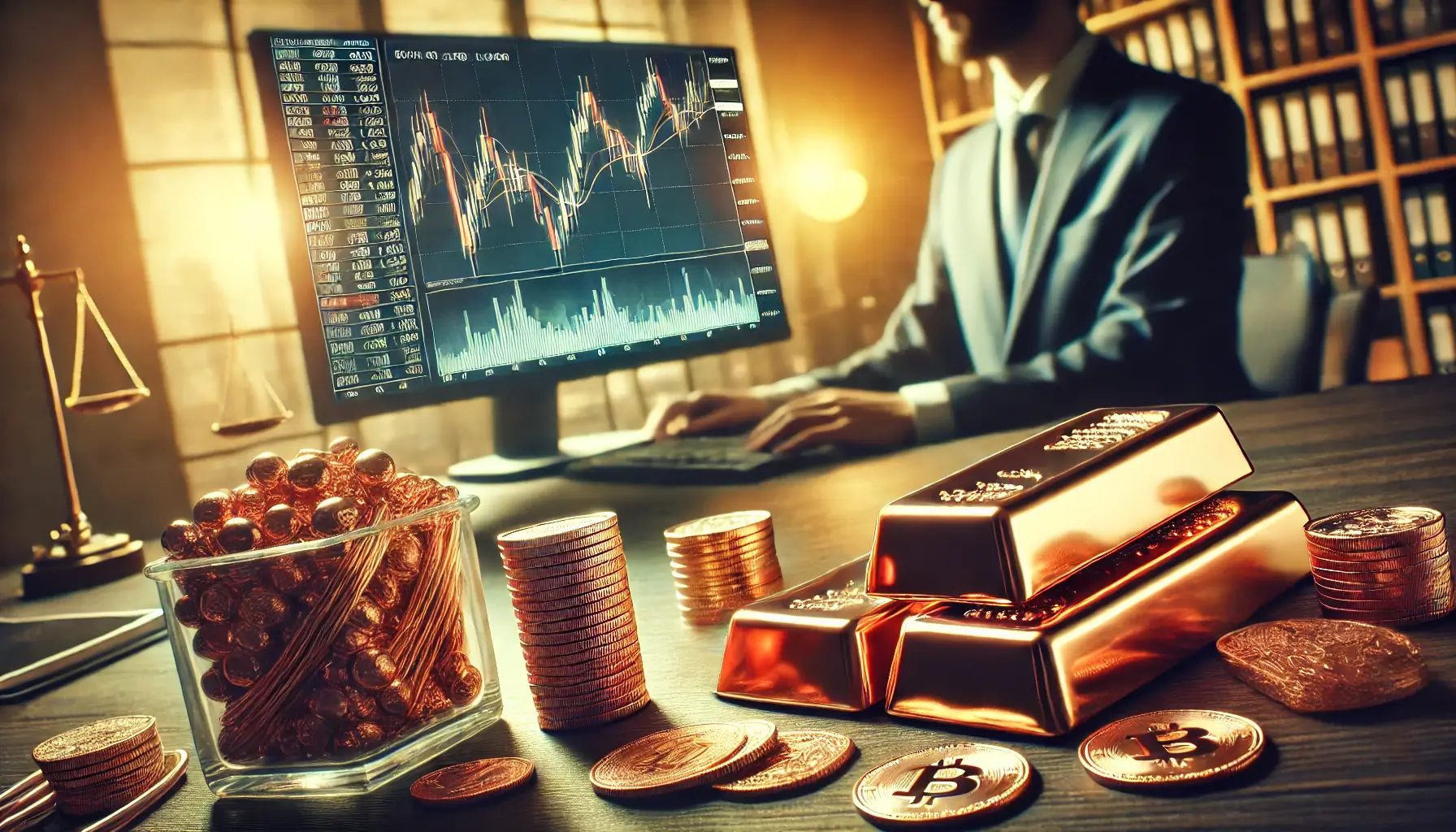How to Invest in Copper Stocks: Best Stocks, ETFs, and Strategies

Introduction

Copper plays a crucial role in various industries, making it a significant asset for investors. As a core component in construction, electronics, and renewable energy sectors, copper's demand remains steady, attracting attention from those looking to diversify their investment portfolios. This versatile metal not only supports essential industries but also presents an opportunity for long-term growth.
Investors often consider copper as a stable and profitable option due to its wide-ranging applications and consistent demand. Whether you're exploring copper stocks or considering copper ETFs, understanding the value of this asset can guide your investment strategy. For a deeper dive into basic materials and their investment potential, check out Richiest.com.
Copper's relevance in today's economy continues to grow, particularly with the push towards renewable energy. As a result, the demand for copper is likely to rise, making it a wise choice for those seeking a reliable investment with growth potential.
Why Should You Invest in Copper?
Understanding the Copper Market
Copper is an essential metal in the global economy, and its market dynamics are influenced by various factors. As an investor, understanding these dynamics can help you make informed decisions about your copper investments. The copper market is characterized by its widespread use in multiple industries, long-term demand trends, and the potential for price volatility. Investors can gain exposure to copper through different methods, including copper mining stocks, ETFs, and futures contracts.
The Demand for Copper in Various Industries
Copper is widely used in industries such as construction, electronics, and renewable energy. As the largest consumer of copper, China plays a significant role in driving global demand. Copper is also a key component in electrical wiring, plumbing, and industrial machinery, making it indispensable in modern infrastructure. Additionally, the shift toward renewable energy has increased the demand for copper in wind turbines, solar panels, and electric vehicles. This broad demand base supports the value of copper as a long-term investment, particularly as these industries continue to grow.
For a closer look at the factors driving the demand for copper and how it impacts the market, visit Richiest.com.
Long-term Investment Potential of Copper
Investing in copper offers significant long-term potential due to the ongoing global demand for the metal. As industries such as renewable energy, construction, and electronics continue to expand, the need for copper is expected to rise, leading to higher prices and potentially strong returns for investors. Copper ETFs, such as the iShares Copper and Metals Mining ETF, provide exposure to copper prices by tracking the performance of companies involved in copper mining and production. These ETFs offer a diversified way to invest in copper without directly owning the metal.
For more insights on copper's long-term investment potential, including how to get involved in the market, refer to Cruxinvestor.com.
What are the Best Copper Stocks to Buy?

Top Copper Mining Companies
When considering investments in copper, it's essential to look at the leading copper mining companies. These companies are at the forefront of copper production and have a significant impact on the market. Major players like BHP Group, Freeport-McMoRan, and Glencore are among the top choices for investors due to their established operations, extensive reserves, and consistent production. Investing in these companies can provide exposure to the copper market and offer potential returns as copper demand continues to grow.
Evaluating Junior Copper Stocks
Junior copper stocks represent smaller, often newer companies in the mining sector. While these stocks carry higher risks due to their limited production and exploration activities, they also offer the potential for high returns. Investors interested in speculative investments may find opportunities in junior copper stocks, as these companies can experience significant growth if they successfully develop their resources. However, it's crucial to conduct thorough research and consider the risks involved before investing in these stocks.
5 Best Copper Stocks to Invest In
Here are five of the best copper stocks to consider for your investment portfolio:
- Freeport-McMoRan (FCX): One of the largest copper producers globally, with extensive mining operations and a strong market position.
- Southern Copper Corporation (SCCO): A leading player in the copper industry, known for its low-cost production and solid financials.
- Rio Tinto (RIO): A diversified mining giant with significant copper production and a history of consistent performance.
- BHP Group (BHP): A top global resources company, offering exposure to copper along with other essential commodities.
- First Quantum Minerals (FM): A growing copper producer with operations in key mining regions and potential for future expansion.
For more detailed information on dividend-paying stocks in the mining sector, visit Richiest.com.
How to Invest in Copper?
Purchasing Physical Copper
Investing in physical copper involves buying the metal in its physical form, such as bars or coins. This method allows you to own tangible assets, which can be stored and sold at your discretion. Physical copper can serve as a hedge against inflation and market volatility. However, it's important to consider storage costs and liquidity challenges, as selling physical copper can be more complex compared to other investment forms.
Investing in Copper ETFs
Copper ETFs (Exchange-Traded Funds) offer a convenient way to gain exposure to copper prices without the need to own physical metal. These ETFs track the price of copper and allow investors to buy shares that represent a portion of the metal. Copper ETFs provide liquidity and can be easily traded on stock exchanges, making them an accessible option for those looking to invest in copper. They also offer diversification, as many ETFs include shares of copper mining companies or futures contracts.
For more information on the benefits of investing in ETFs, refer to Blackrock.com.
Trading Copper Futures Contracts
Copper futures contracts are agreements to buy or sell a specific amount of copper at a predetermined price on a set date in the future. This method of investing allows for speculation on copper prices, providing the potential for significant profits. However, it also carries substantial risks due to the volatility of the futures market. Futures trading is generally suited for experienced investors who are familiar with the risks involved and can manage the potential losses.
For additional insights into high-dividend stocks, including those related to copper, visit Richiest.com.
What Are the Risks of Investing in Copper?

Volatility in the Price of Copper
Copper prices can be highly volatile, influenced by various factors such as economic cycles, supply disruptions, and changes in demand. This volatility presents a risk for investors, as the value of copper-related investments can fluctuate significantly over short periods. Investors need to be aware of these price movements and consider strategies to manage this risk, such as diversification or using stop-loss orders to limit potential losses.
Geopolitical Risks Affecting Copper Supply
Geopolitical factors play a significant role in the copper market. Many of the world's largest copper mines are located in regions that can be politically unstable. Changes in government policies, mining regulations, or international trade agreements can disrupt copper supply chains, leading to price fluctuations. Investors should keep an eye on geopolitical developments in major copper-producing countries, as these can have a direct impact on the availability and cost of copper.
Environmental and Regulatory Risks in Copper Mining
Copper mining faces numerous environmental challenges and regulatory hurdles. Mining operations can have significant environmental impacts, including habitat destruction, water pollution, and carbon emissions. These issues often lead to stricter regulations and increased costs for mining companies. As governments and organizations push for more sustainable practices, the copper industry may face additional regulations, potentially affecting profitability and investment returns.
For more detailed information on investing in basic materials, including copper, refer to Richiest.com.
What are the Options for Investing in Copper?
Buying Shares of Copper Mining Companies
Investing in copper mining companies is one of the most direct ways to gain exposure to copper. By purchasing shares in companies that mine copper, you can benefit from the growth in copper demand and price increases. When choosing copper mining stocks, it's essential to consider factors such as the company's production capacity, cost structure, and geographical location. Companies with efficient operations and significant reserves are often better positioned to thrive in fluctuating market conditions.
Investing through Copper ETFs and ETNs
Copper ETFs (Exchange-Traded Funds) and ETNs (Exchange-Traded Notes) offer a straightforward way to invest in copper without owning the physical metal. These financial instruments track the price of copper and can include a variety of underlying assets, such as futures contracts or shares of copper mining companies. ETFs and ETNs provide a convenient option for investors looking to diversify their portfolios with exposure to copper, as they are traded on major stock exchanges and can be bought and sold easily.
Exploring Copper Futures and Options
Copper futures and options are advanced investment strategies that allow investors to speculate on the future price of copper. Futures contracts are agreements to buy or sell copper at a set price on a specific date in the future. Options give investors the right, but not the obligation, to buy or sell copper at a predetermined price. These instruments can offer significant profit potential, but they also come with high risk due to the volatile nature of the copper market. Futures and options trading is generally recommended for experienced investors who are familiar with the complexities of these markets.
For more insights on different kinds of investments, including those related to copper, visit Richiest.com.
Conclusion

In conclusion, copper has long been recognized as a valuable asset in various investment portfolios. With the ability to produce copper on a large scale, major copper mining operations have become central to global copper supply, often producing millions of tons of copper annually. Copper ETFs, such as the Global X Copper Miners ETF and the United States Copper Index Fund, provide exposure to the performance of copper without directly owning the metal. These ETFs are focused on copper, allowing investors to benefit from rising copper prices and price movements.
Investing in individual stocks of companies that operate copper mines is another way to gain exposure to this essential metal. Top copper stocks, which often include those involved in both copper and gold production, offer potential dividends and growth opportunities. For those looking to speculate on copper, copper futures ETFs and the Sprott Junior Copper Miners ETF present higher-risk options with potentially significant returns.
Although copper prices can be volatile, investing in a diversified basket of copper-related assets can help mitigate risks. Whether through direct ownership, ETFs, or copper futures, there are multiple ways to capitalize on the long-term potential of copper in a portfolio that balances stocks and bonds.
FAQs
What is the best way to invest in copper?
The best way to invest in copper depends on your investment goals and risk tolerance. Common options include buying physical copper, investing in copper mining stocks, or purchasing copper ETFs. Physical copper offers direct ownership but involves storage costs. Copper mining stocks allow you to benefit from the growth of companies in the industry, while copper ETFs provide a diversified approach with easier trading. Each method has its advantages and drawbacks, so it's important to choose the one that aligns with your financial objectives.
Are copper stocks a good long-term investment?
Copper stocks can be a strong long-term investment due to the growing global demand for copper, particularly in sectors like renewable energy and electronics. As these industries expand, the need for copper is expected to rise, potentially leading to higher stock prices for companies involved in copper production. However, it's important to consider market volatility and geopolitical risks when investing in copper stocks, as these factors can impact long-term returns.
How do copper ETFs work?
Copper ETFs work by tracking the price of copper through futures contracts or by holding shares in copper mining companies. These ETFs allow investors to gain exposure to copper without the need to buy physical metal. Copper ETFs are traded on stock exchanges, making them accessible and easy to buy or sell. They offer a convenient way to invest in copper while providing diversification within the sector.
What are the risks of investing in copper stocks?
Investing in copper stocks comes with several risks, including price volatility, geopolitical uncertainties, and environmental regulations. The price of copper can fluctuate based on global economic conditions, supply disruptions, and changes in demand. Geopolitical risks, such as changes in mining regulations or trade policies, can also impact copper production and prices. Additionally, stricter environmental regulations may increase operational costs for mining companies, affecting their profitability.
How do I choose the best copper stocks to invest in?
Choosing the best copper stocks requires careful analysis of the company's financial health, production capacity, and market position. Look for companies with strong balance sheets, efficient operations, and a history of consistent production. It's also important to consider the geographical location of their mines, as this can influence their exposure to geopolitical risks. Researching market trends and staying informed about industry developments can help you make informed decisions when selecting copper stocks to invest in.